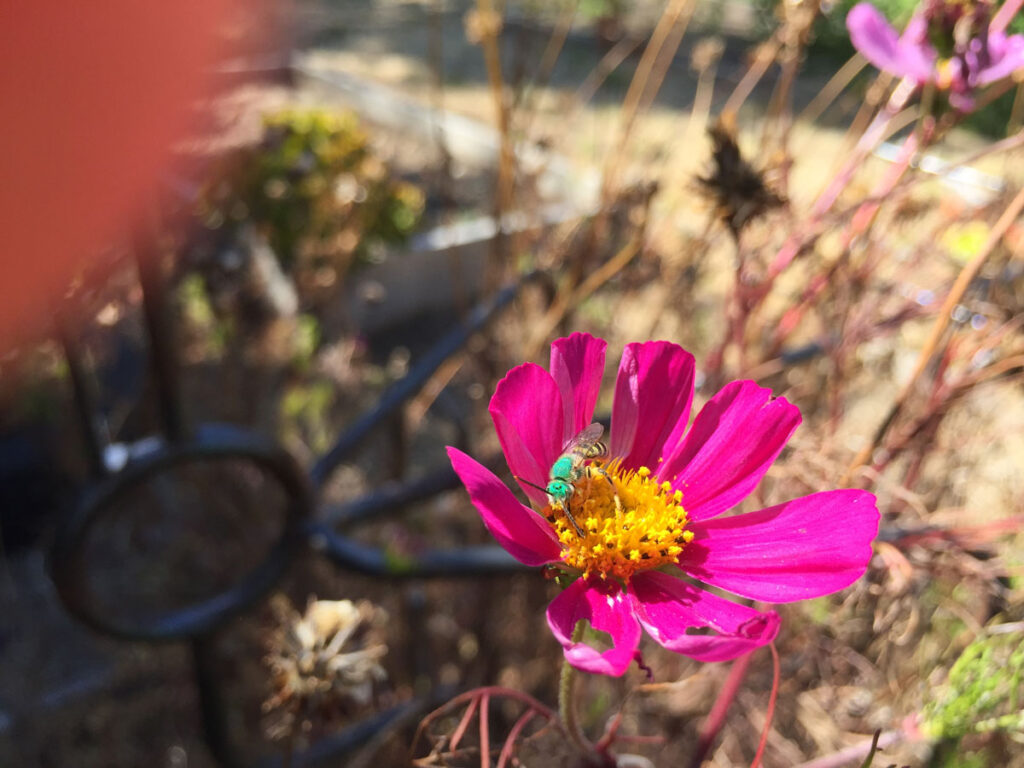Around the world, city residents build gardens on balconies, rooftops, and small strips of land. A new study published in Ecology Letters confirms that beyond offering food and an outlet for cultivating outdoor space, urban gardens provide benefits for the humans, insects, and animals who inhabit these leafy respites from city life.
Much of the world’s population lives in cities—places not typically considered prime habitats to research the intersection of people, plants, and pollinators. Agriculture may conjure images of endless fields of singular crops. The small garden in a busy neighborhood, however, may bring to mind an entirely different story.
“There are a lot of studies that claim that food production is at odds with saving biodiversity and other ecosystem services,” which are the benefits that nature provides, wrote Stacy Philpott, an ecologist at the University of California, Santa Cruz, and one of the authors of the study, via email. “But our study did not uphold these previous findings,” she added.
Measuring a Garden’s Impact
Over 5 years, Philpott and her colleagues collected data from 28 community gardens along California’s central coast, aiming to show how cultivating verdant space, even in a city, can create a thriving ecosystem. Besides counting beneficial insects, such as pollinators and predators of garden pests, the researchers cataloged features such as the numbers of trees and flowers, types of ground cover, and how much natural habitat surrounded each plot.
These data helped Philpott and her colleagues determine whether natural trade-offs occurred among ecosystem services such as food production, pollination, pest control, water conservation, carbon sequestration, climate regulation, and human well-being.

The researchers asked questions like the following: Do certain plants have a positive or negative effect on the number of pollinators present? If food production is high, is biodiversity low? They also looked at the natural habitat surrounding the gardens and evaluated whether it influenced either trade-offs or synergies among ecosystem services. “We asked whether certain garden features tended to promote some ecosystem services but not others,” Philpott wrote.
The researchers found more synergies and fewer trade-offs; ecosystem services tended to connect to one another in a positive manner. “This means that carbon sequestration, water conservation, or biodiversity conservation in a garden doesn’t need to come at the expense of food production,” Philpott wrote. A community garden can provide food and support its gardeners while also offering a habitat for a diverse range of life.
Certain garden management techniques, such as mulching a bed, had both positive and negative effects on the ecosystem services measured—adding mulch to a bed increased carbon sequestration but decreased pollinator activity. “Typically, we found that plant diversity in a garden was less important for promoting beneficial insect biodiversity when there was more natural habitat in the landscape,” Philpott wrote.
“It’s good to see a study focusing on the urban environment where most people live.”
“It’s good to see a study focusing on the urban environment where most people live,” said Signe Danler, a horticulturist at Oregon State University who was not involved in the study. “They evaluated so many different factors. Any ecosystem is very complicated, and an urban ecosystem may be even more so,” she added.
The study shows that urban gardeners can utilize a small patch of land to contribute to their neighborhood’s biodiversity as well as their own well-being. Conserving natural habitat, including weeds, might attract more good neighbors, such as pollinators and predators of garden pests. “Plant more plants and let them grow naturally. Allow some untidiness,” Danler said. “Physical health, mental health: all of these are made better by having healthy nature and ecosystems around you.”
—Rebecca Owen (@beccapox), Science Writer
This news article is included in our ENGAGE resource for educators seeking science news for their classroom lessons. Browse all ENGAGE articles, and share with your fellow educators how you integrated the article into an activity in the comments section below.


